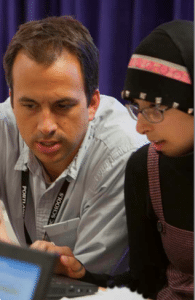Mud Season and Modules
CompetencyWorks Blog

One of the things that Making Mastery Work: A Close-Up View of Competency Education brings into focus is the number of design choices competency-based schools and districts have in deciding how to shape their models. For example, there are lots of design choices about time. Yes—all of the schools share a belief that time is a variable and not a constant. Yet, how they begin to create flexible use of time varies substantially.
Below are two examples from Making Mastery Work about how two schools organize time for students. I realized while preparing this post (ahh, writing is such a great way to force deeper understanding!) that it’s not an issue of just more time or less time, extended or expanded time. There are other dimensions such as constructing “time” for application of learning including project-based, problem-based, and fieldwork. There are also dimensions about how much time is expected between steps, such as modules, trimesters, semesters, and transitional time to provide flexibility. It seems to me that we should be able to figure out some common language to expedite our thinking strategically and through multiple dimensions in how we use time.
Casco Bay High School, Portland Maine: To facilitate student access to the power of collective learning, Casco Bay organizes its students into grade-level cohorts, and its school day has recognizable bell schedule with block periods. The block periods make it possible for students to undertake the deep thinking work required by Expeditions while also providing flexibility to accommodate student learning outside the classroom, such as fieldwork. … At two points during the school year, Casco Bay offers “Intensives” in which students study one topic for a number of days. Intensive topics range from Bridge-Building Engineering to Winter Sports. A smaller portion of students also use this time to continue working toward mastery of learning targets they have not yet achieved.
This schedule also affords opportunities for students who need more time to master material, whether they have specific learning needs or not. Intensives can be used for Independent Study of material from regular coursework or for tutoring. Casco Bay has also created a Mud Season School in March and a Summer School in July. Students who have been unable to successfully complete coursework can enroll in either of these programs. Unlike traditional credit recovery programs, students do not repeat courses offered during the school year in Mud or Summer School. Instead, teachers offer opportunities for students to work on specific learning targets that the coursework covered.
Boston Day and Evening Academy, Boston, MA: Beneath the surface of a seemingly conventional school schedule and calendar, there is striking flexibility. Trimesters and summer school allow students to enroll at three points and graduate at four points during the year (new students do not enroll in summer school, but students can finish and graduate at the end of the summer)… Trimester-long courses are thematic and cover a sequenced set of competencies and benchmarks. In one trimester the six-person Day and Evening Science Department offers a broad range of courses: Bio-Chemistry, Physics I & II, The Cell, Ecology, Genetics, Evolution, Advanced Biology, and Advanced Science. Students can select amongst a similarly diverse set of courses in Math and Humanities.
Perhaps more importantly, students have flexibility both within and beyond these offerings. If a student is placed in a course and quickly discovers that she knows some of the material, she can be assessed on that material and move forward independently on the material she does not know. If a student needs more time to complete a course, he can take it again, beginning the work where he left off, or he can request to work independently on missing learning targets. The Math Department has supported this flexibility by creating engaging modules using their competencies. The curriculum can be accessed “anytime and anywhere,” but students can also enroll in the Math POLL (Personalized Online Learning Lab) where they can do their own work while receiving support from a math teacher.
In reflecting upon your school, what are the ways you are thinking about using time flexibly? What are the undergirding principles or design criteria that you are using to make your design decisions?